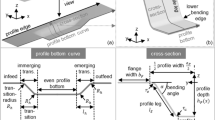Abstract
Beads that alter the geometry of sheet parts can increase the stiffness of deep drawn sheet parts. The locations and geometry of the beads have a great influence on the stiffness of the parts. The design of beads is the result of numerous bead optimisations, developed without considering the manufacturability. Therefore, a bead optimisation algorithm should be developed to increase the efficiency of the bead design while simultaneously considering manufacturability. The trajectory generated along the principal direction of bending stress determines the locations of the beads that maximise the stiffness of the parts. Formability is chosen as a criterion that effectively suggests itself for the initial bead geometry during bead optimisation. The influences of the deep drawing depth, initial specimen geometry and bead height on formability are then investigated by means of a sensitivity analysis. The maximum formable bead height as function of pre-strains is derived from this sensitivity analysis using linear superposition and second order polynomial fitting. The initial bead height function will play a crucial role in supplying the initial values and the validity of the simulation model is experimentally confirmed by the chosen bead locations and geometry.














Similar content being viewed by others
References
Bendsøe MP, Kikuchi N (1988) Generating optimal topologies in structural design using a homogenization method. Comput Methods Appl Mech Eng 71:197–224
Yang RJ, Chen CJ, Lee CH (1996) Bead pattern optimisation. Structl Optim 12:217–221
Luo JH, Gea HC (1998) Optimal bead orientation of 3D shell/plate structures. Finite Elem Anal Des 31(1):55–71
Altair Computing User’s Manual, Version V5.0 (2000)
Emmrich D (2004) Entwicklung einer FEM-basierten Methode zur Gestaltung von Sicken für biegebeanspruchte Leitstützstrukturen im Konstruktionsprozess. Dissertation, Karlsruhe Institute of Technology
FE-Design (2009) TOSCA User’s Manual. FE-Design GmbH, Karlsruhe
Maressa A, Pluymers B, Donders S, Desmet W (2010) NVH optimization methodologies based on bead modification analysis in vehicle body design. Proc of ISMA2010, Leuven, Belgium, pp 4319–4336
Leiva JP (2011) Structural optimization methods and techniques to design efficient car bodies. International Automotive Body Congress, Michigan, pp 41–55
Bilik C, Pahr DH, Rammerstorfer FG (2012) A bead laying algorithm for enhancing the stability and dynamic behavior of thin-walled structures. Acta Mech 223:1621–1631
Krönauer B, Majic N, Golle M, Hoffmann H, Albers A (2010) Automated bead de-sign considering production constraints. NUMIFORM 2010, Pohang, pp 13–17
Werber A, Liewald M, Nester W, Grünbaum M, Wiegand K, Simon J, Timm J, Hotz W (2013) Assessment of forming limit stress curves as failure criterion for non-proportional forming processes. Prod Eng Res Devel 7:213–221. https://doi.org/10.1007/s11740-013-0446-6
Stoughton TB, Yoon JW (2012) Path independent forming limits in strain and stress spaces. Int J Solids Struct 49:3616–3625
Volk W, Suh J (2013) Prediction of formability for non-linear deformation history using generalized forming limit concept (GFLC). AIP Conf Proc 1567:556–561
Barlat F, Brem JC, Yoon JW, Chung K, Dick RE, Lege DJ, Pourboghrat F, Choi S-H, Chu E (2003) Plane stress yield function for aluminum alloy sheets—part 1: theory. Int J Plastic 19:1297–1319
Safaei M, Waele WD (2014) Study on the definition of equivalent plastic strain under non-associated flow rule for finite element formulation. Int J Plasticity 58:219–238
Banabic D (2010) Sheet metal forming process. Springer, Berlin, ISBN:978-3-540-88112-4
Abaqus 6.12 documentation © Dassault Systèmes (2012)
Weinschenk A, Volk W (2017) FEA-based Development of a new tool for systematic experimental validation of nonlinear strain paths and design of test specimens. AIP Conf Proc 1896:020009. https://doi.org/10.1063/1.5007966
Schwarz D (2002) Auslegung von Blechen mit Sicken. In FAT-Schriftenreihe 168:55–56
Majic N (2014) Development of a FEM-based method for the design of production-oriented bead patterns for bending loaded support structures. Dissertation, Karlsruhe Institute of Technology, pp 1615–8113
Acknowledgements
The authors would like to thank the German Research Foundation (DFG) for funding the research described here. This project DFG AL 533/29-1 and VO 1487/7-1 is supported by DFG.
Author information
Authors and Affiliations
Corresponding author
Rights and permissions
About this article
Cite this article
Cha, WG., Müller, S., Albers, A. et al. Formability consideration during bead optimisation to stiffen deep drawn parts. Prod. Eng. Res. Devel. 12, 691–702 (2018). https://doi.org/10.1007/s11740-018-0850-z
Received:
Accepted:
Published:
Issue Date:
DOI: https://doi.org/10.1007/s11740-018-0850-z




